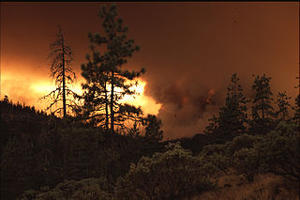WildfiresForecasting long-lived wildfires
Scientists have developed a new computer modeling technique that offers the promise, for the first time, of producing continually updated daylong predictions of wildfire growth throughout the lifetime of long-lived blazes. The technique combines cutting-edge simulations portraying the interaction of weather and fire behavior with newly available satellite observations of active wildfires.

Wildfire in the Pacific northwest // Source: wikimedia.org
Scientists have developed a new computer modeling technique that offers the promise, for the first time, of producing continually updated daylong predictions of wildfire growth throughout the lifetime of long-lived blazes.
The technique, devised by scientists at the National Center for Atmospheric Research (NCAR) and the University of Maryland, combines cutting-edge simulations portraying the interaction of weather and fire behavior with newly available satellite observations of active wildfires.
Updated with new observations every twelve hours, the computer model predicts critical details such as the extent of the blaze and changes in its behavior.
A UCAR release reports that the breakthrough is described in a study appearing in an online issue of Geophysical Research Letters, after first being posted online last month.
“With this technique, we believe it’s possible to continually issue good forecasts throughout a fire’s lifetime, even if it burns for weeks or months,” said NCAR scientist Janice Coen, the lead author and model developer. “This model, which combines interactive weather prediction and wildfire behavior, could greatly improve forecasting — particularly for large, intense wildfire events where the current prediction tools are weakest.”
Firefighters currently use tools that can estimate the speed of the leading edge a fire but are too simple to capture crucial effects caused by the interaction of fire and weather.
The researchers successfully tested the new technique by using it retrospectively on the 2012 Little Bear Fire in New Mexico, which burned for almost three weeks and destroyed more buildings than any other wildfire in the state’s history.
The research was funded by NASA, the Federal Emergency Management Agency (FEMA), and the National Science Foundation (NSF), which is NCAR’s sponsor.
Sharpening the picture
In order to generate an accurate forecast of a wildfire, scientists need a computer model that can both incorporate current data about the fire and simulate what it will do in the near future.
Over the last decade, Coen has developed a tool, known as the Coupled Atmosphere-Wildland Fire Environment (CAWFE) computer model, which connects how weather drives fires and, in turn, how fires create their own weather. Using CAWFE, she successfully simulated the details of how large fires grew.
